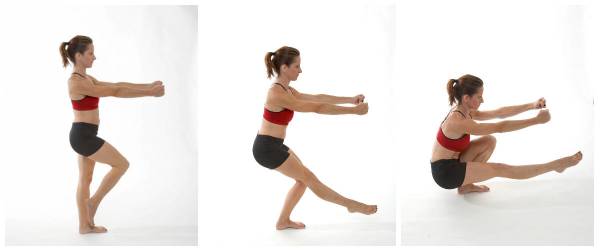Pistols have a wide array of athletic and real-world applications. The fundamental skill that pistols teach is how to exert power through the entire range of motion of your stance, all while on one leg. Whether you’re running, jumping, or changing directions in an athletic competition—or walking, sitting, or standing in your daily affairs—powerful legs enable us to do what we do better, and with greater ease. The combination of skills that pistol practice develops simultaneously, things like stabilization, strength, mobility, and coordination, make it one of the most useful and important exercises to learn.
How to Perform a Pistol
The description of the pistol is the easy part.
- Stand on one leg, with the other leg out in front and parallel to the floor.
- Your hands are kept to the side or in front for counterbalance.
- Sit back and down, as if sitting in a very low chair.
- At the bottom, of the position, your support foot is flat and your hamstring/glute is resting on your calf.
- Stand back up to the starting position.
That is one rep.
As simple as the description sounds, the performance of the pistol is actually a sophisticated motion to learn. To start you on your path of mastering this powerful movement, let’s look at the component parts of the exercise.

The Components of a Pistol
The reason that learning to do pistols well is so challenging is that they involve an interplay of several different physical skills, all performed simultaneously. Below are the primary components involved. An inability to perform the pistol is a result of a deficiency, or “weak link,” in one or more or these components:
- Stabilization – Pistols teach “rooting,” as in the roots of a tree, forming a solid connection to the ground. Because we are shifting the body’s center of mass over a narrow base of support, and for an extended range of motion, balance is challenged and trained in a dynamic fashion. Specifically the foot ankle, knee, and hip are stabilizing the body position and movement of the pistol.
- Mobility – The muscles and joints of the legs, low back, hips, and ankles are required to work at the extreme ranges of motion, both in flexion and extension.
- Strength – The powerful muscles of the glutes and thighs are moving the body weight throughout a very narrow base of support, thereby recruiting tremendous stabilizer function in all the lower body joints; tension is maintained throughout the eccentric, isometric, and concentric portions; the core musculature is recruited to maintain balance and alignment.
- Coordination – The neuromuscular system is challenged by the multiple requirements involved in pistol practice-balancing, contracting and elongating.
- Focus/Mental Attitude – A clear focus and concentration is required to maintain control over the body; fear and restricted movement is overcome by releasing our fear of falling and reintroducing freedom of motion.
The pistol follows the same mechanics as a regular squat. The difference is that a pistol is performed with a much narrower base of support, thereby increasing the challenge to stability and mobility. Before learning to squat on one leg, be sure to first know how to squat correctly on two.
As you begin to improve the depth of your squat also begin to narrow the stance of your squat. Narrow stance bodyweight squats are a good place to assess your range of motion and mobility. If you can get to the floor and back up again multiple times without raising the heels or falling backward you are ready for other points of the pistol squat.
The next place to train in order to prepare for learning pistols is your single leg deadlift. This will help increase your body’s ability to stabilize the movement. In particular, it targets ankle, knee, and hip stabilization. Without this key component, you cannot do the pistol effectively or safely. These are taxing on the nervous system so they should be trained methodically and not to the point of fatigue.
Strength is the other component of the pistol. One may think strength in terms of leg strength but it is more about total body tension including your abs, lats, and elongation of the back when performing a pistol. Once you have trained your mobility, stabilization, and strength you may try the deck (rock-up) squat which allows you to practice the correct mechanism for pistols.
The Role of the Pistol
Of all the exercises to practice, pistols are one of the most advanced movements because they incorporate so many different things at once—stabilization, balance, mobility, flexibility, strength, coordination, and focus. The best way to master the pistols is to start doing them in low repetition in a “grease the groove” fashion. Because they are extremely intense on the nervous system so you will not be able to train for as many reps or for as frequently.
In my opinion, pistols are most useful as a bodyweight exercise, because most applications (sports, fall prevention, housework, etc.) require the ability to control your own body at various velocities. Weighted pistols are a great way to train as well. A low-weight kettlebell (8kg), dumbbell or plates can be used to provide a counterbalance for those that need it.
Feel free to email me for progressions and regressions for working your pistol. I am more than ready to help you! You can reach me via email or connect with me on my website.






